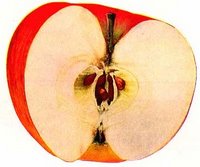
The Apple: from Kazakhstan to You
What is probably the most universal fruit in the world had it's origins in the mountains of central Asia where a species of tree that still grows there has been tentatively indentified as the ancestor of every apple we eat today. The "Alma", as it's known in the region, was eventually domesticated into the many varieties of apple we see today.
Chiefly propagated by grafting, eating apples are one of the first examples of bio-engineering by humans. Plant a seed from a store bought apple and you'll get a tree with very different fruit. Apples as we know them can only be obtained by human intervention and humans have been hard at work. There are thousands of apple varieties recorded and probably many more that have been lost to history.
Due to their easy storage in a cold cellar, apples are known the world over as a winter fruit. The apple provided an essential nutritional boost to people living in temperate zones where food became scarce in the cold. In Britain where the very tart Crab Apple has been grown since ancient times, cider was an important product as the nutritious and potentially very alcoholic drink could be stored and consumed over the long dark winter. Olden herbal medicine recommended drinking unsweetened apple cider to prevent kidney stones.
A dish called "Apple Moyse" was once concocted from leftover cider mash by combining it with egg yolks, sugar, butter and rose water. Cooked in a steamer, the resulting dish was seasoned with cinnamon and spread on biscuits. Apple butter seems to be an American decendent of this ancient recipe.
Apples were used medicinally in Europe for a variety of conditions, from gout to rheumatism to indigestion. It was thought that apple sauce helped the body digest greasy foods like goose and roast pig. Even rotten apples found a use as a poultice for sore eyes. I'll skip that one. The Chinese claim that apples are cooling to the body while strengthening the heart and lubricating the lungs. A lubricated lung is a good thing in Chinese medicine.
The United States was for many years an apple eaters paradise with hundreds of varieties bred around the country. This was almost completely lost with the advent of long-distance trucking. Before the 1930's, every region had it's own unique varieties of apple. Some were so esteemed that people would plan trips just to savor a particular region's specialty.
Most apple varieties don't travel well so unique apples would stay near the region they were grown. When the food industry turned to trucking after World War II, the search turned to finding apples that could stand the jostling of an extended truck journey. By the 1960's only a few apple varieties could be purchased at your supermarket. And to many these apples were not the best as the time it took to get the apple to the shelf lost the just picked flavor.
Fortunately an apple renaissance is on it's way as people are rediscovering the apple heritage of the United States. Many varieties presumed lost are being rediscovered in abandoned orchards or in hidden corners of old estates and farms. And many apple farmers are experimenting and discovering new varieties never seen before. It's now not unusual to find dozens of different apples at local farmer markets. The range of flavors is amazing compared to the common store apple. From tastes that suggest rose perfume to very strong wine-like aromas.
Lookin At Cookin strongly suggests that the next time you visit a farmers market, try one of each, we are sure you'll discover a variety you'll like. This writer's favorite last year was the Northern Spy apple, a variety discovered in the early 1800's. How it got that name I couldn't guess. For further info on the many apple varieties, here is an excellent website: http://www.applejournal.com/use.htm .
Oct 15, 2006
Posted by
The Videoddgrapher
at
7:31 AM
![]()
![]()
Subscribe to:
Post Comments (Atom)

No comments:
Post a Comment